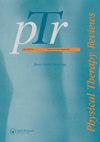封锁对脊柱疼痛的影响:关于使用“2020年封锁问卷”的初步报告
IF 0.8
Q4 REHABILITATION
引用次数: 0
摘要
摘要背景:为了遏制新冠肺炎疫情在意大利的传播,意大利于2020年3月实施了封锁,迫使人们花更多的时间呆在家里。虽然人们认识到,生活习惯的相关变化改变了他们的心理健康,但生活质量也取决于身体健康。这对于那些患有肌肉骨骼疾病的人来说尤其重要,比如脊椎疼痛。目的:认识到脊椎疼痛是一种生物-心理-社会病理学,我们制定了一份问卷,调查由脊椎疼痛引起的残疾程度(在封锁期间出现或增加)与受访者对日常生活活动限制的看法之间的潜在关联。方法:在文献中没有类似工具的情况下,开发并试用了一种专门的问卷工具。它由4个部分组成:两份专门为本研究制定的自我报告问卷和两份已经验证的问卷。对来自10个私人康复机构的110名参与者进行了治疗。所有受试者都是年龄段的,在封锁期之前或期间都有腰椎和/或颈椎疼痛,无创伤性病因。结果:大多数参与者认为他们的脊椎疼痛在封锁期间出现或加剧。第二份问卷的这一项目与两个残疾量表之间的列联表证实了这种看法与调查时的残疾程度之间可能存在联系,这两个量表显示出统计学上的显著相关性。结论:该调查工具在该人群中有效,建议进一步研究。本文章由计算机程序翻译,如有差异,请以英文原文为准。
Influence of lockdown on spinal pain: a preliminary report on use of the “2020 lockdown questionnaire”
Abstract Background: In order to contain the spread of the Covid-19 pandemic in Italy, a lockdown was issued in March 2020, which has forced people to spend much more time at home. While it is recognised that the associated change in life habits has changed their psychological well-being, quality of life also depends on physical well-being. This is particularly important for those with musculoskeletal conditions, such as spinal pain. Objectives: Recognising that spinal pain is a bio-psycho-social pathology, we developed a questionnaire to investigate potential associations between the level of disability caused by spinal pain (that arose or increased during the lockdown period) and the perception of the respondents with respect to the limitations of activities of daily living. Methods: In the absence of similar tools in the literature, a dedicated questionnaire tool was developed and piloted. It consists of 4 parts: two self-report questionnaires specially formulated for this study, and two already validated questionnaires. It was administered to 110 participants from 10 private rehabilitation facilities. All subjects were of age and had lumbar and/or cervical spine pain occurring before or during the lockdown period with non-traumatic etiopathogenesis. Results: The majority of participants perceived their spine pain as having arisen or increased during the lockdown period. The existence of a probable connection between this perception and the degree of disability at the time of the survey is confirmed by the contingency tables between this item of the second questionnaire and both disability scales which showed a statistically significant correlation. Conclusions: The survey tool was found to be valid in this population, and is recommended for further studies.
求助全文
通过发布文献求助,成功后即可免费获取论文全文。
去求助
来源期刊

Physical Therapy Reviews
REHABILITATION-
CiteScore
1.30
自引率
0.00%
发文量
26
期刊介绍:
Physical Therapy Reviews is an international journal which aims to publish contemporary reviews, discussion papers and editorials within physical therapy, and in those basic and clinical sciences which are the basis of physical therapy. The journal is aimed at all those involved in research, teaching and practice within the area of physical therapy. Reviews (both descriptive and systematic) are invited in the following areas, which reflect the breadth and diversity of practice within physical therapy: •neurological rehabilitation •movement and exercise •orthopaedics and rheumatology •manual therapy and massage •sports medicine •measurement •chest physiotherapy •electrotherapeutics •obstetrics and gynaecology •complementary therapies •professional issues •musculoskeletal rehabilitation
 求助内容:
求助内容: 应助结果提醒方式:
应助结果提醒方式:


